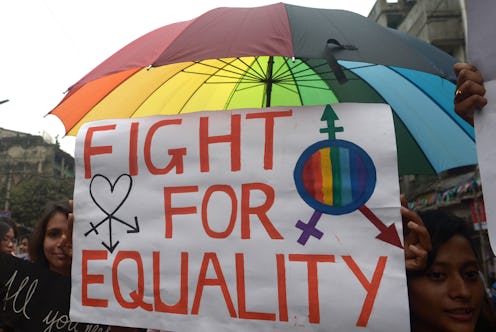News
The Sad Target Of Anti-Transgender Legislation
Lesbian, gay, bisexual, and transgender activists — who feared complacency on vital issues heading into 2016 — might find that the biggest hurdle placed before them after 2015's historic push for LGBT rights will actually be legislative backlash. Twice as many bills targeting the rights of transgender people were introduced nationwide in the first two months of 2016 than during all of 2015, according to a new report from the Human Rights Campaign. More than half of the 44 anti-transgender bills the HRC identified as currently under consideration by lawmakers target trans children. And the scene for many of these political battles? The bathroom. As state and federal governments clash over transgender rights, public schools are getting caught in the middle.
In 2015 — a year that saw the introduction of Caitlyn Jenner, a Supreme Court ruling in favor of marriage equality, and legislation that gave transgender people the right to serve openly in the military — 21 bills targeting transgender rights were introduced throughout the country. The HRC called the 44 anti-trans bills already introduced this year alarming. "This deeply disturbing trend is a stark reminder of just how vicious and deplorable opponents of equality are in their relentless attacks against our community," HRC President Chad Griffin said.
"Bathroom bills," such as the one currently sitting on the desk of South Dakota Gov. Dennis Daugaard, would require transgender public school students to use restrooms and other facilities which correspond with the "chromosomes and anatomy" assigned to them at birth. The South Dakota Senate approved the bill 20-15 last week, despite warnings from the U.S. Department of Justice and the U.S. Department of Education that the bill would place the state's public schools in direct violation of Title IX, which prohibits discrimination against transgender and gender nonconforming students. The Department of Education clarified its interpretation of how Title IX protects transgender students in 2014, stating, "under Title IX [a school] must treat transgender students consistent with their gender identity in all aspects."
The South Dakota lawmaker behind the so-called "bathroom bill" has said that it is an attempt to push back "against federal overreach and intrusion into our lives." South Dakota Rep. Fred Deutsch told ABC News that the bill "is an attempt to regain control of something as basic and common sense as privacy rights for our children while at school."
But in the clash between state and federal governments, it's the school districts (and, I think it goes without saying, transgender students) who'll end up feeling the consequences. The bill would place the state's public schools between a rock and a hard place, as implementing it could result in pricey litigation when complaints are filed with the Department of Education's Office for Civil Rights.
South Dakota isn't alone in targeting transgender children. According to the HRC, nearly two-dozen bills have already been introduced this year aimed at prohibiting transgender students from using sex-segregated facilities like restrooms and locker rooms in accordance with their gender identity.
Proponents of "bathroom bills" like South Dakota's argue that the legislation protects cisgender boys and girls' bodily privacy rights, implying that incidence of sexual assault will rise if transgender people are allowed into the proper bathrooms. It's a myth which assumes that behind the door of school bathrooms is a parade of unclothed genitals freely on display for spectators. It's been 10 years since I stepped into a public school bathroom, but I doubt things have changed that much. Rather, under the auspices of protection, South Dakota's bill erodes the equality of an already vulnerable population.
